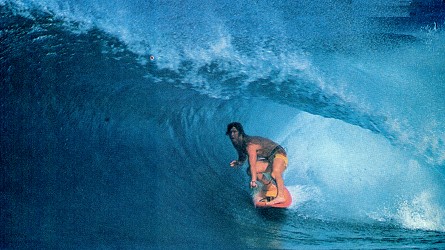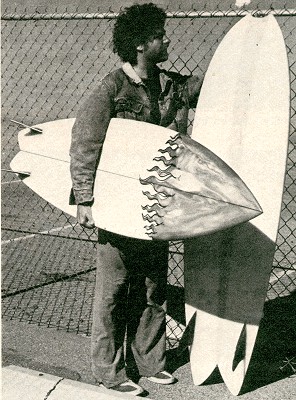pods
for primates : a catalogue of surfboards in australia since 1900
 |
surfresearch.com.au
the
catalogue #40 |
|
| 1978 Mark Richards
Twin fin II 5 ft 10" |
#40
|

MANUFACTURE
MANUFACTURER: Maddog Surfboards,
Industrial Estate, Byron Bay
SHAPER: Bob Margetts
DESIGN: Mark Richards' Twin fin
2
DESIGNER: Mark Richards
SPECIFICATIONS
CONSTRUCTION: Foam blank, 1/8"
redwood stringer, spray, r/h plug
DIMENSIONS
|
Length :
|
5
|
ft |
11
|
inches |
L2 : 5 ft
|
10''
|
|
Width :
|
19 3/4
|
inches |
|
Wide Point :
|
/+ x
|
inches |
|
Nose :
|
14 1/4
|
inches |
|
Tail :
|
14 1/2
|
inches |
|
Thickness :
|
2 1/2
|
inches |
|
Pod :
|
5 3/4"
|
inches |
|
Nose Lift :
|
|
inches |
|
Tail Lift :
|
|
inches |
|
Weight :
|
|
kilos |
|
Volume :
|
|
litres |
|
Swallow:
|
1 1/2
|
inches |
deep |
Flyer:
|
7
|
inches |
FEATURES
Nose: Pin
Tail: swallow tail,
flyer
Deck: flat
Bottom: slight Vee
in nose, deeper at fins, channel from fin base to rail
Rails: Tucked
Rocker:
FINS
6" x 5" base x 7'' span @ 10 1/2''
Brewer, inside flat/outside foiled,
toed and tipped/cambered
Gold/white/red (3) laminate, |
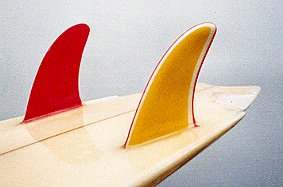 |
DECOR
DECALS
Deck
1.'Mark Richards' script and ribbon
graphic, light blue/silver
2.'Shaped by Bob Margetts'
black, tail
Bottom
'Mark Richards'
script and ribbon
graphic, dark blue/white
MARKINGS
Deck: RM ,
pencil
Bottom:
COLOUR
Deck
Gold wing, nose to flyer + red winged
foil, with black pinlines
Bottom: clear |
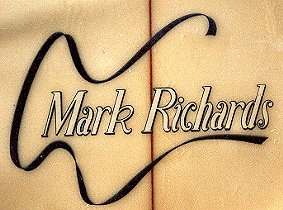 Alternative later decal
below
Alternative later decal
below |
NOTES
BOARD HISTORY
Donated by John McInnes May 1996.
Repairs to swallow/flyer tips and leg
rope damage.
SHAPER HISTORY
Knox:
Mark
Richards
DESIGN HISTORY
See below.
COMMENTS
Legrope damage indicates possible pre
rail saver use, tip damage to the tail is emdemic to this design.
REFERENCES
Other Boards
#165
Book
Knox:
Mark
Richards pages 61 to...
Film
Free Ride1977 Bill Delany
, Water footage by Dan Merkel.
Surfers : Shaun Tomson, Mark Richards
and
Rabbit Batholomew
*The definite film of this period,
note that most of Mark Richards' surfing is not on a Twin fin II .
CONDITION: 8


DESIGN
HISTORY
circa 1943
The earliest documented twin fin surfboard
is probably a model built by Tom Blake, possibly in Hawaii, circa 1943.
See cropped image, below.
The uncredited photograph is currently
the only known evidence.
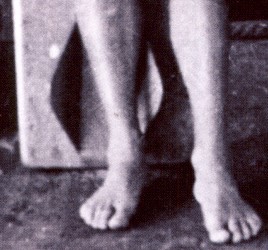
|
circa 1943,
Tom Blake Twin fins,
Timber
4 x 12 b @ 2 inches (Approximation)
Hollow timber board.
Note fin camber.
The feet are Tom Blake's.
Uncredited photograph,
Australian Surfers Journal
Vol 3 No 1 Summer 2000 page 10. |
1948
Probably unaware of Blake's examle,
Bob Simmons in California developed a multi fin design in 1948.
He only manufactured a small number of
his long based Twin fin model but, like most of his innovations,
the long term impact was considerable.
The design was certainly influenced by his design research, based on
Linsay Lord's
Naval
Architecture of Planing Hulls (1946).
It is also slightly possible that Simmons had noted Twin fins on some
prone boards in this period.
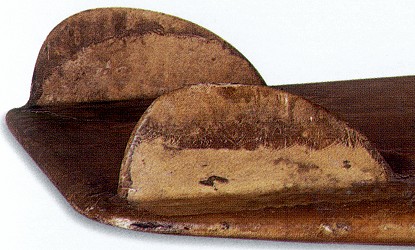 |
1948
Simmons' Twin
Fin
Wood and fibreglass
6 x 12 b @ 2 inches (approximation)
Bob Simmons' Laminate Board, USA.
Dick Metz Collection, Dana Point, California.
Blackburn,
page 73 |
1950's
During the 1950's prone boards appeared
in a plethora of designs and constuction methods.
See the Paipo
catalogue for examples dating from the 1930's.
A large proportion were finless, those
that did attach a fin used a longbased keel type fin.
Bellyboarders at some stage incorpated
twin fins on their wide tailed boards, similar to the plywood example,
right.
With the introduction of foam blanks these
design were reproduced in the new medium.
See Barry Bennett example, below. |
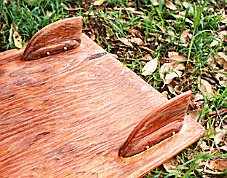 |
A short lived, but well documented, experiment
by California's Dale Velsey was the Butterfly fin.
Essentially two fins joined at the base
it was futuristic in template and concept.
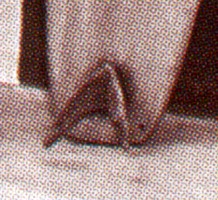
|
1955
Butterfly Fin
Laminated Timber
8 x 7 b @ 4 inches (Approximation)
Velsy-Jacobs Surfboards USA
Photograph : Bob Meistrell
Longboard Magazine
Vol 12 No 1 March -April 2004 page
33. |
The single fin template used
by Velsey would not become common use until 1974.
Apparently the production difficulties
were not offset by improved performance.
In 1978 the design was revived as a molded
model for use in a standard fin box.
The design was also (slightly) reflected
in the Horan/Lexan Star Fin, 1980.
Fin experimentation on surfboards1950 to
1966 was extensive.
A variety of designs, some extreme, proliferated,
however singularity and a standard 0'' to 6''placement remained a design
constant.
1960
With the introduction of foam blanks,
bellyboard riders had their plywood designs were reproduced in the new
medium.
Generally the fins retained the long base
keel profile and, consistant with surfboard fins of the era, foiling was
minimal.
Placement was close to the tail with the
fins vertical to the bottom and parrallel to the stringer.
1962 - 1964
In the US George Greenough built his first
Velo
Spoon in balsawood in 1962.
He reported that the board was originally
...
"a twin fin, but as time went
on, I moved the fins closer together, and it
kept working better and better.
Eventually, it turned into a single fin!"
- George Greenough,
The Australian Surfer's Journal
Volume 2 No 2 Autumn 1999 pages 84, 86
and 87.
1964
"When Curren visited me at Surfboards
Hawaii in Haleiwa during 1963,
he had a 9'4" full gun, an 8'4"
semi-gun 3" thick, and a 4'6" twin-fin kneeboard.
All these boards were ahead of their
time."
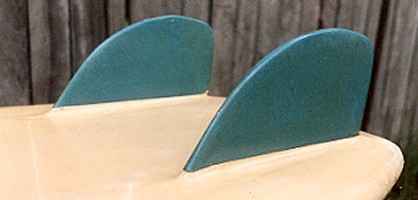 |
1964
Twin Keel Fins,
Pigmented chop strand mat
4 1/2 x 9 1/2 b
@ 1 inches
# 50
Barry Bennett Surfboards Belly board
, |
circa 1967
Bear Mirandon of Surfboards La Jolla
used Simmons' Twin fin design and matched them with a slpit tail design.
There was a precedent of this design in
some early prone boards, see Blackburn.

Surfboard La Jolla
Twin-Pin, 1967
Length 8'9" - Nose 17" Width
22" Tail 17"
Shaped by La Jolla reef maven Bear
Mirandon, the double-pin
tailed twin-fin was an update of
a Bob Simmons concept.
This board led directly to the Fish
kneeboard design
of Steve Lis, which is still very
much in use today.
Photograph by Bjorn de Boer
Image and caption
Longboard Magazine, Volume
2 Number 2, August - September 1994 page 69
In the USA, the situation was similar
with a noted following lead by kneeboarders Steve Lis and Rex Huffman.
Lis was credited with the development
of The Fish, a design with long base twin fins and a split 'Fish'
tail, circa 1969..
From the La Jolla area, Steve Lis was
aware of an earlier design by Bear Mirandon precedent.
The fish tail was later supplanted by
the Swallow tail.
Twin Fin I, see #71
and #106, a circa 1970 design by Mike
Eaton / Rolf Arness / Corky Carroll / David Nuuihwa -all USA.
Imported to Australia by Tom Hoye (USA)
at Bennett Surfboards, the design had a strong following in Sydney,
particularly at Narrabeen) by McCoy Surfboards.
Image right:
Tom Hoye and Twin Fin, Bennett Surfboards,
1970
Photograph Tracks Magazine.
Nat-History,
page 106.
Although the design quickly disappeared
from mainstream production in Australia, a number of surfers found the
design complimented their style or local conditions.
Over the next six years a small number
of Twin-fins were produced as custom boards. |
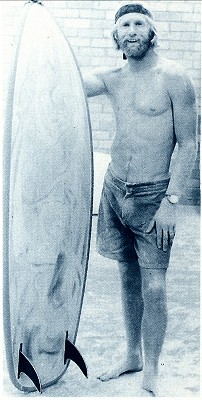 |
From 1974, in conjunction with Billy
Tolhurst and influenced by Reno Abellira's early Fish designs, Ronnie Goddard
began experimenting with twin fins.
Local interest was negligible in
these designs until the contest success and media recognition of Mark Richards'
Twin fin, circa 1978.
- from Ronnie Goddard interview,
Scott Dillon's Legends Surf Museum,
Coffs Harbor, June 29th 2005.
The use of twin fins on prone
boards, common in the 1960's, continued into the 1970's, for example the
mass produced
Bellybogger, 1975.
The design was adopted by standup surfers,
a longer version with with a more standard fin template, was designated
The
Rocket Fish, circa 1974, the name at least credited to Clyde Beatty.
There is much dispute amoungst US commentators
as to the originators of the design.
This was to influence Reno Abellira, (Hawaii)
who rode a 5 ft 3" x 20" model in the 1976 Coke contest, Sydney.
Familiar with the Twin Fin I and inspired
by Reo, Mark Richards built his own version and subsequently refined
it at a month long shaping seminar with Dick Brewer in Hawaii 1976-1977.
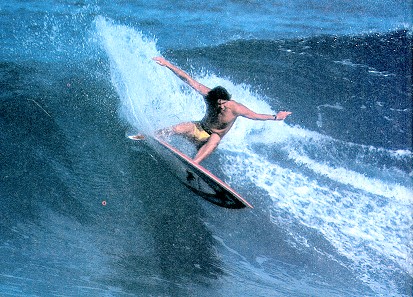 |
Mark Richards and 6ft 4'' Twin
Off The Wall, 1977.
Photograph : Lance Trout
Surfing
Magazine February 1980.
Volume 16 Number
2, page 90. |
Mark Richards and 6ft 4'' Twin
Off The Wall, 1977.
Photograph : Lance Trout
Surfing
Magazine June-July 1978.
Volume 14 Number
3, page 47 |
|
The design was tested in Hawaii the following
winter and contest success in the Bells 1978 and Stubbies 1979 contests
and the 1979 World tiltle proved its high performance capabilities, particularly
in small waves. Available from all Australian manufacturers, it was the
dominant small wave board design 1978 – 1981.
Image right :
Steve Brom and Rocket Fish, circa 1977.
Photograph : Brian Gillogly
Surfer Magazine, Volume 18 Number 2, page 57. July 1977.
Note :
Fins toed and tipped.
Long base/short height profile.
Estimated length 5 ft 10''.
Twin pin nose on vertical board. |
|
The design also had a strong following on
the south shore of Ohau, notably Larry Bertlemann and 'Buttons', and
was to be extensively used in the USA.
Mark Richards models were made under licence
by Gordon and Smith Surfboards.
House shapers were Hank Warner, Robin
Prodanovich, Terry S. Goldsmith and E. Duck.
These were available with Star System
fin boxes, a uncommon feature in Australian boards.
Advertisement : Surfing Magazine
June 1981.Volume 17 Number 6, page 93.
 |
Mark Richards Twin fin, (est. 6 ft 3'')
Gordon and Smith Surfboards (USA)
Surfing Magazine June 1981.Volume
17 Number 6, page 93. |
Star Systems Twin fin,
Mark Richards Model
Gordon and Smith Surfboards (USA)
Surfing Magazine May 1979.
Volume 15 Number 5, page 9.
|
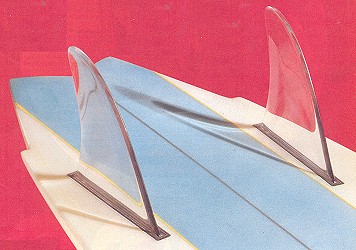
|
In Australia, the design was shaped by
Mark Platter, Ken Freeland and Tony Cerff at Maddog Surfboards.
Mark Richards Surfboards (single fin designs)
were first manufactured by Morning Star Surfboards, Mona Vale.
The fin to flyer channels rarely appear
on later/copied examples.
The ribbon decals were early designs,
gradually replaced by a MR/Lightning Bolt, a MR script and a MR/Lizard
graphic.
Apparently the famous MR/Superman logo
only appeared on Mark Richards' personal boards during this early period.
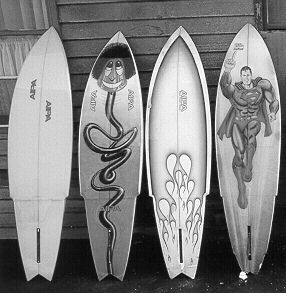
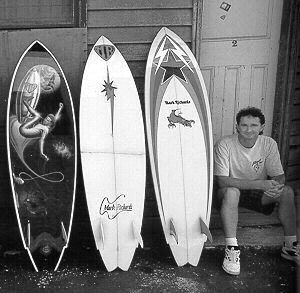
Photograph by Peter Boskovic
Printed in The Australian Surfers Journal
Vol 1 # 3 Winter 1998 page 44
Note : Original Apia Surfboards 'Flame'
Stinger, Twin fins with various decals.
All boards much photographed.
Other Twin Fins II (old Scale)
 |
Mark Richards' first Twin fin II,
based on Reno Abelira's Fish, Coke Contest 1976
Photograph: Andrew Canning |
 |
#39 Bryne Bros. Surfboards Twin
Fin II 1978
Shaped by Laurie Byrne. |
 |
#119 Hawaiian 1979 Hawaiian Pro
Designs, Twin fin II. 6 ft 1" Larry Bertelmann Model |
 |
#55 Pipedreams Flyer Roundtail Twin
Fin II 1979 6 ft 2'' |

surfresearch.com.au















